How the classic English novel spread throughout the Jewish world and its many languages

In late April of 1719, the English author Daniel Defoe published the story of the wonderful tales of Robinson Crusoe. Crusoe was a young Englishman who ran away from home at the age of 18. He spent a few years on merchant ships in the New World, was taken captive at sea and became a slave of the North African Moors. After escaping captivity, he settled in Brazil and bought an orchard where he, a freed slave, hired African slaves who were forcibly brought to the New World. From Brazil he decided to embark on a trade expedition that ended in a shipwreck on a deserted island.
At first, he spent his days building a shelter to protect from predators and natives whom he believed inhabited the island. When the awaited deliverance failed to arrive, he began establishing a new one-man civilization. Crusoe lived on the island for 28 years before returning to England, his homeland, along with a friend he met on the island. He made a promise to never disobey his father again and to refrain from dangerous adventures at sea, but this vow was not kept for long. Though the novel’s plot was a figment of Defoe’s imagination, the author’s name did not appear on the cover of the book’s first editions and Crusoe’s memoirs were depicted as authentic.
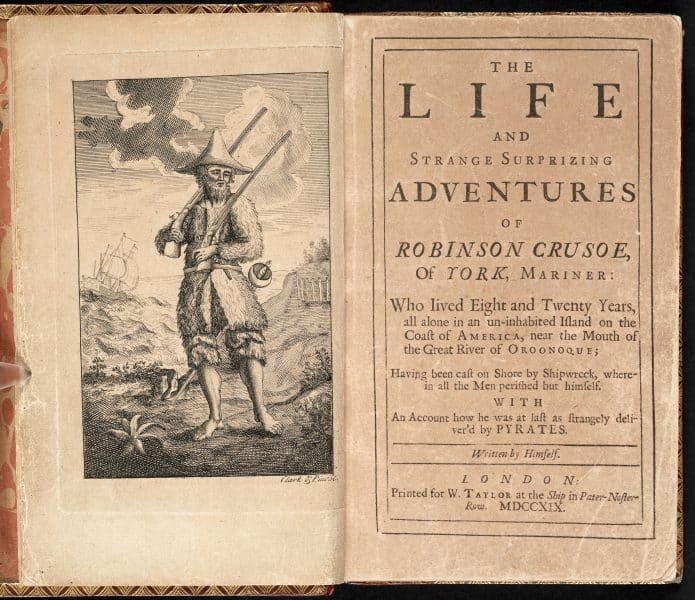 The first edition of The Life and Strange Surprizing Adventures of Robinson Crusoe, 1719, held at the British Library
The first edition of The Life and Strange Surprizing Adventures of Robinson Crusoe, 1719, held at the British Library
1,000 copies of the original April 1719 edition of Robinson Crusoe were printed. The May edition consisted of another 1,000, and an additional 1,000 copies were printed in June of that year. The same year, the novel was translated into French, German and Dutch. By the beginning of the 20th century, Hebrew readers – or more accurately readers of the Hebrew letter – living in Thessaloniki, Warsaw and Tunisia, could choose from approximately ten different translations of the tales of Robinson Crusoe. However, most Jewish readers would have their first encounter with the character through a later adaptation of the novel, which appeared in Germany in the 18th century; This German adaption was created in the year 1779/1780 by the teacher and author of children’s books, Joachim Heinrich Campe.
As previously noted, in the first year Robinson Crusoe was published, the name of the author did not appear on the book which was initially presented as a record of the true adventures of an English sailor who survived for 28 years on a deserted island. Campe created a new structure for Defoe’s realistic novel – a didactic book delivering a universal moral in the form of a father telling his children a story. When the time came and Campe’s book was adapted into various other languages, most Jewish translators omitted its dialogue-like style but kept the educational tone, which they preferred to the religious Christian tone of the original novel.
The first “Jewish” translation of the work remained in the realm of European language. This edition was in fact a Hebrew transliteration of German (German in Hebrew letters), published in 1784/1785. A single copy is kept at the British Library. Aside from various omissions, the transliteration remains largely faithful to the Campe adaptation.
The second version, also in German transliterated into Hebrew characters, was published in Frankfurt in 1813. A copy of the transliteration is kept at the National Library of Israel and can be accessed via the following link. It is called The Story of Rabanizn (מעשה ראבאניזן).
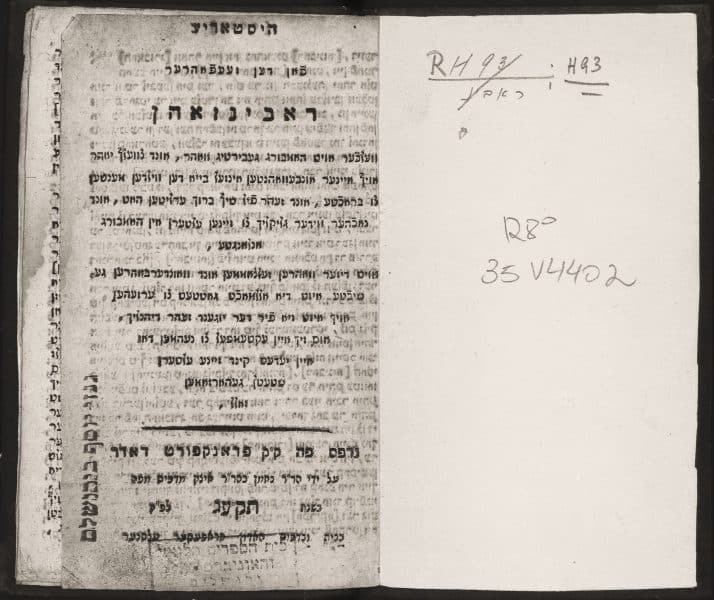
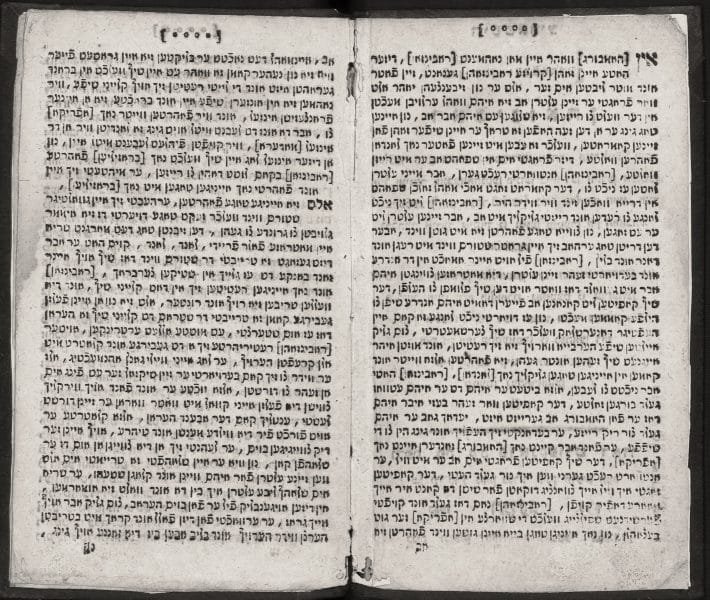 German in Hebrew characters: The Story of Rabanizn by Daniel Defoe, unknown translator, 1813
German in Hebrew characters: The Story of Rabanizn by Daniel Defoe, unknown translator, 1813
Why translate into German instead of into Hebrew or Yiddish? One theory is that the translation was meant to bring readers closer to German culture; another is that it was motivated by commercial concerns. Either way, the most popular version of Defoe’s bestseller among European Jewish readers was not written in German at all…
The first translation into a Jewish language is the one attributed to the maskil Yosef Vitlin, who translated Campe’s adaptation into Yiddish. It is probably the most successful Jewish adaptation of the novel in the 19th century and we have much evidence of its great popularity. Campe’s didactic tone is preserved but the dialogue between a father reading to his children and the children answering was omitted. The book’s title translates into ‘Robinson: The history of Alter Leb: a true and wonderful story for entertainment and education.’ It can be viewed here.
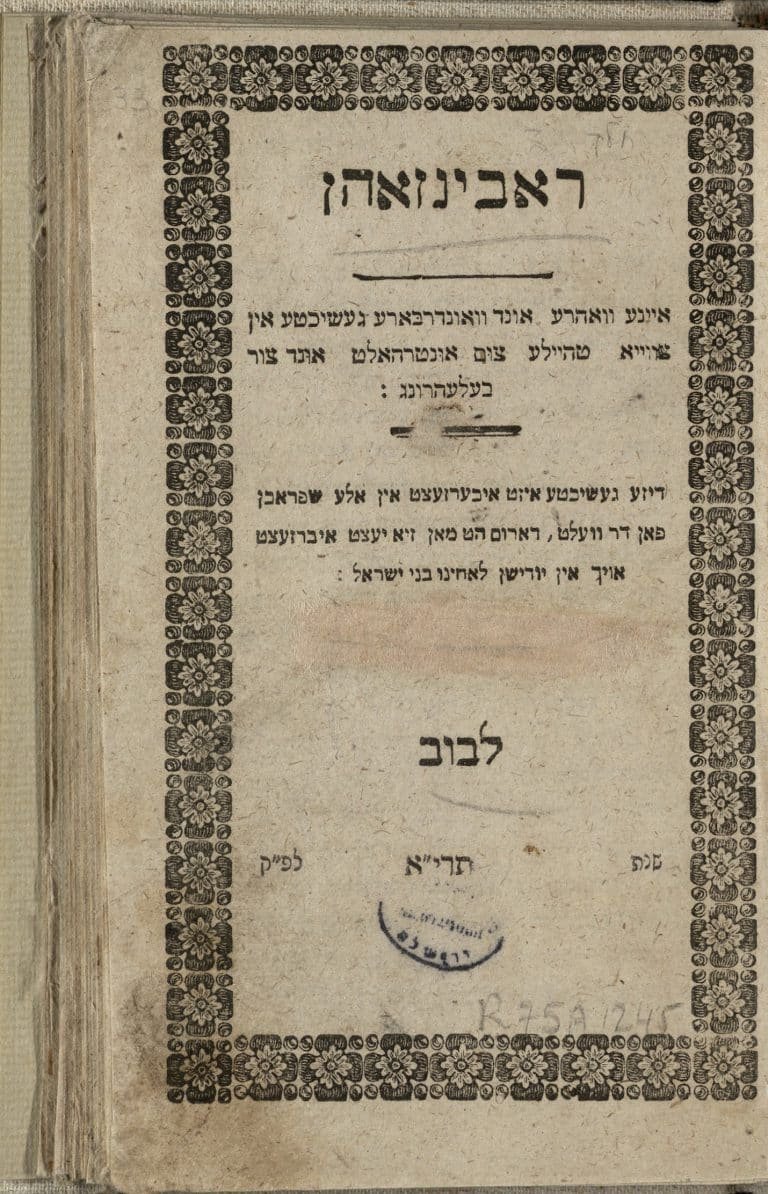
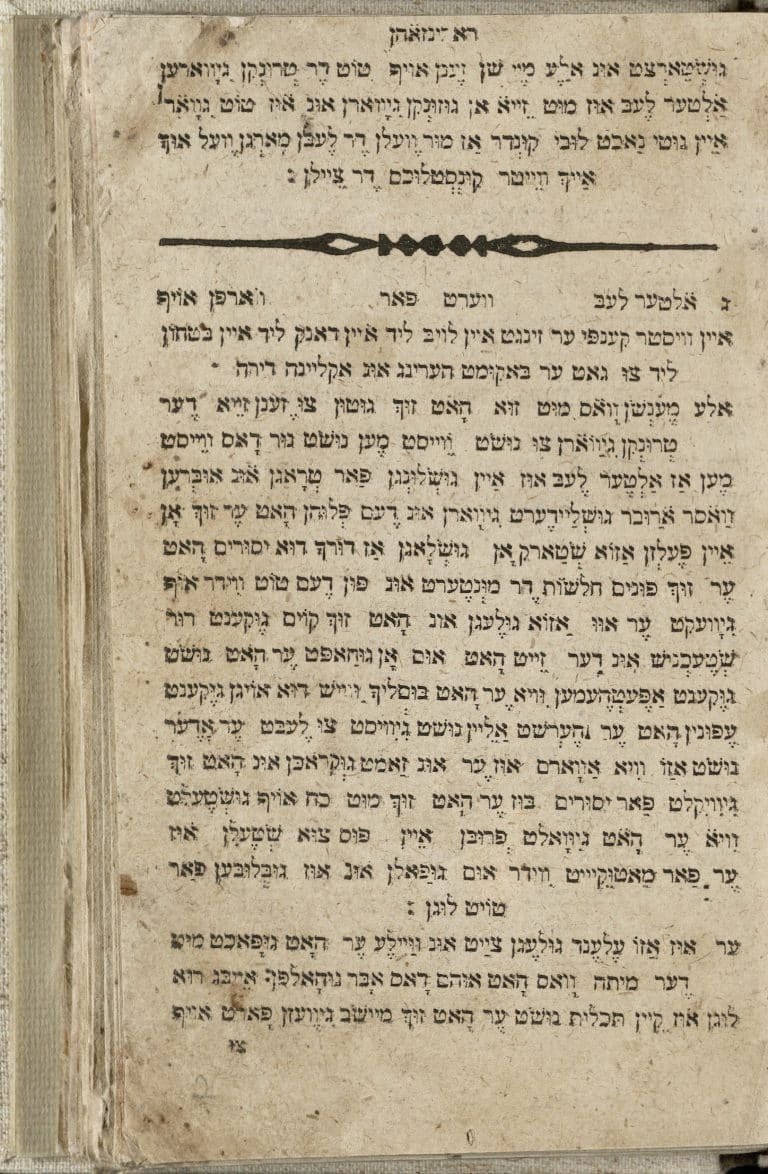
The first Yiddish adaptation/translation: Yosef Vitlin’s “Alter Leb”, 1820s
The work’s name indicates just how far apart the English Crusoe and the Yiddish Alter Leb were. Alter Leb is Robinson Crusoe’s alter ego, and he is the hero of Vitlin’s translated novel. A rich Jewish merchant from Lemberg, Alter starts out as a drunk transgressor. As the story unfolds, the translator takes several opportunities to teach readers about the basics of sailing – how to use an anchor and what a lighthouse is – while also offering lectures on Jewish law.
Alter Leb isn’t the only character with Jewish characteristics; his companion, named Friday in the original novel, is called ‘Shabbos’ (Sabbath) here. Shabbos teaches Alter how to quickly light a fire and Alter teaches Shabbos about monotheism, the Torah and the Sabbath customs. Seeing as Alter Leb’s prayers are answered time and again throughout the novel, it’s hard to say which of the two benefited more from their companionship. The story concludes with a good Jewish ending – Torah study, proper spouses for Alter and Shabbos, and lives lived happily ever after with plenty of cute children all around. Amen!

Robinzon der yingere (“The Young Robinson”), translated by David Zamośź, 1824
From Yiddish, we move on to Hebrew. The first Hebrew translation of Robinson Crusoe was written in 1823/1824 by the Galician maskil David Zamośź, though we will not elaborate on it here. This translation is also loyal to Campe’s adaptation, and it is the only version that keeps the structure of the father speaking with his children.

The beginning of the first Hebrew translation of Robinson Crusoe by David Zamośź, 1824
The reason we won’t go into detail is simple: The second translation is considered far more influential and includes some fascinating additions to the Hebrew language. This translation was titled Kour Onni (“The Furnace of Affliction”), written by Yitzchak ben Moshe Rumsch and first published in Vilnius in 1862. Rumsch was a teacher at a government boys’ school and later became the principal of a private girls’ school. Translating the book into Hebrew was not a simple task. For example, Rumsch decided to leave the names of people and places in Yiddish transcript (ראבינזאן, לאנדאן, בראזיליען), while providing Hebrew alternatives for many of the tools used by Robinson. Rumsch even coined Hebrew terms for the words ‘telescope’ (קנה הָרֳאי) and ‘compass'(מַרְאֶה-פְּאַת-הצפון), though these were not generally accepted into the Hebrew canon.
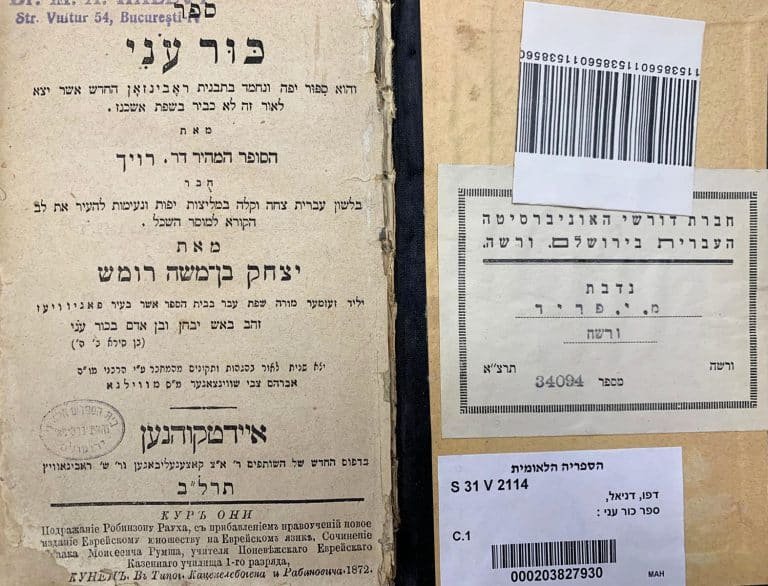
Kour Onni, the second Hebrew translation by Yitzchak ben Moshe Rumsch, 1872
In the introduction to Rumsch’s translation, he discounts the previous complete Hebrew translation. It is unclear if he blames David Zamośź for the poor job or if he attributed the flaws he saw in the translation to the state of the Hebrew language at the time, though it is clear he felt it was his role to make things right. Particularly unnerving for him was Zamośź’s use of Mishnaic Hebrew. Rumsch and others in his generation preferred Biblical Hebrew. Rumsch’s translation coined the modern Hebrew term for “breakfast”, or more literally “morning meal” (ארוחת בוקר), which is a combination of two biblical words replacing the Mishnaic פת שחרית which can be literally translated as “dawn’s bread/morsel”.
We mentioned that this was a particularly influential translation and now it’s time to prove it: One famous reader was Eliezer Perlman, who would soon change his name to Eliezer Ben-Yehuda, commonly known as the “reviver of the Hebrew language”. Perlman came across the book in the possession of his teacher, Rabbi Yossi Bloyker, and wrote as follows:
And gradually and quickly he began to tell me, little by little, that there are books written beautifully and poetically in the holy language, and one time as I sat before him to study a ‘Gemara page’, and no one was home, he pulled out a small book from under his seat and opened it and told me to read before him. It was the book Kour Onni, a Hebrew translation of the story of Robinson Crusa. Before I could read two pages there was a knock on the door. And the head of the yeshiva grabbed the book from my hand and hid it back under his seat, and together we returned to discuss the issue in the Gemara before us.

Eliezer Ben-Yehuda working on his great dictionary, the Abraham Schwadron Collection at the National Library of Israel
Yael Baruch shared a similar, though naturally different, story about her grandparents in Tunisia.
In the 1930s and 1940s in Tunisia, children and adults would visit the home of Rabbi Rahamim Baruch and his wife Simcha on Sabbath mornings to hear the honorable Rabbi read from a different book each time. Two novels were at the forefront on those mornings: The Count of Monte Cristo and Robinson Crusoe. The translations were in Judeo-Arabic, the language of North African Jews. In the National Library catalog, we found the translation from which Rabbi Baruch used to read to the neighborhood children. The title of the translation was Ḥikayat Robinson Krusoi translated by Hai Sitruk. It is a condensed version of the novel, and in it, too, Robinson Crusoe tells the story of his adventures.


Ḥikayat Robinson Krusoi, translated into Judeo-Arabic by Hai Sitruk, (apparently) during the first decade of the 20th century
In a bibliography written in 1939 by the Jewish Tunisian author Daniel Hagège, we find a few crumbs of information on the English novel’s Judeo-Arabic translator. Like Yitzchak Rumsch, Hai Sitruk worked as a school principal at a large boys’ school in Tunisia, which was later used as the Agudat Zion (Zionist Society) building. His work, including Ḥikayat Robinson Krusoi (The Stories of Robinson Crusoe) was first printed at a publishing house owned by the Vazan family in Tunisia. From the 1930s on it was printed at the Makhluf Najar publishing house in the town of Susah. This wasn’t Sitruk’s only translation of world literature; he was also a proofreader, journalist, and the translator of Alexander the Great, The Mysteries of Paris, and more.
The decision to translate Robinson Crusoe into the language of the North African Jews is somewhat surprising. Most of the Judeo-Arabic translations of world literature were of French origin, not English. French literature was often translated into yet another Jewish language – the language of the Spanish exiles.
Two Ladino translations of Robinson Crusoe were written at the end of the 19th century; the first translation was created in 1881 and published in Thessaloniki. The translation was printed as the third and final part of a book called Bracha Ha’meshulushet. It was printed again in the year 1900. The editor of the second version was Elijah Levi. The translation ends with Robinson Crusoe in his second year on the deserted island.
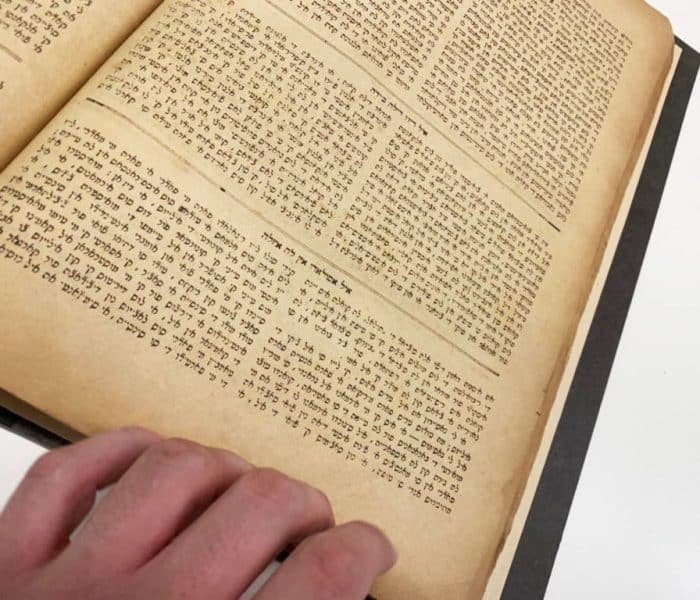
El isolado en la isla (“The Isolate on the Island”), a Ladino translation by Elijah Levi, 1881
In 1897 the second Ladino translation of Robinson Crusoe was published in Jerusalem. The translator, Ben-Zion Taragan, was a Hebrew teacher; this is noticeable in the way his translation is influenced by Hebrew syntax. Here and there we find a Turkish word thrown into his 150-page-long translation. This translation covers most of the original novel’s story.
In the beginning of Taragan’s Ladino translation, which we were able to loosely translate into Hebrew with the help of Ilil Baum, Robinson Crusoe addresses the readers in an attempt to lure them to read on:
Many of you, my dear readers, have surely heard my name, and many of you had the privilege of seeing me in my goat leather clothes with my loyal dog, cat and parrot at my side, and will surly take great pleasure in hearing my story. And now I am here before you to tell you my story, and I truly hope you learn many good things from it.
It may be that this introduction, which is different than the beginning of the original novel and that of Campe’s adaptation, is an original adaptation by the translator. The translation ends with three educational pieces on ethics, the last of which is directed at young girls.

The second Ladino translation, La ermoza istoria Robinson o la miseria.
This is a late edition published in Constantinople in 1924, translated by Ben-Zion Taragan
For both the Ladino and Judeo-Arabic languages, the first half of the 20th century was the golden age of popular literature intended for adults and teens. The Robinson Crusoe translations are one example of that. The golden age which began at the turn of the 20th century ended with the outbreak of WWII. The Holocaust was terribly destructive to Yiddish and Ladino culture. Most of the world’s Ladino speakers were murdered when the Jewish communities of Thessaloniki and other Ladino centers in the Balkan were nearly completely wiped out. The fate of the Yiddish language was all too similar.
Following the waves of immigration to Israel after the establishment of the Jewish State, Judeo-Arabic has gradually faded away and is rarely used today. We may not see new translations of the work into these three languages which continue to struggle in the early 21st century. On the other hand, it is likely that in Israel the classic book will continue to be translated and updated so long as the local language, Hebrew, continues to evolve. A translation into an additional local language, Arabic, was published in 1835 by an anonymous translator in Europe. As for the second most widely-spoken language in today’s Jewish world, readers can simply choose to make their acquaintance with Robinson and Friday, in the original English.
Many thanks to Iris Idelson-Shein, Anabel Esperanza, Ilil Baum, Marta Katarzak, Tamir Karkason, David Guedj, Yael Baruch, Idan Perez and Ofek Kehila for their cooperation in writing this article.
Sources:
Alpert, Michael. “The Ladino Novel”, European Judaism 43, no. 2 (2010)
Backscheider, R. Paula. Daniel Defoe: His Life, Johns Hopkins University Press, 1989
Baroukh, Nehama. 2010. “’A Language That Was Torn from its Biblical Slumber’: Changes and Shifts in Written Hebrew (1880–1980) as Reflected in Translation of Books for Children.” [In Hebrew.] PhD diss., Tel Aviv University
Garrett, Leah. “The Jewish Robinson Crusoe.” Comparative Literature 54, no. 3, (2002).
Idelson-Shein, Iris. Difference of a Different Kind: Jewish Constructions of Race during the Long Eighteenth Century (Philadelphia, 2014), 151-178
Judeo-Arabic Literature in Tunisia, 1850-1950, Wayne State University Press, 2014
Saraf, Michal. “Daniel Hagege and His Essay on the History of Judeo-Arabic Literature in Tunisia, 1862-1939” (in Hebrew), Pe’amim 30 (1987): 41-59.
Shavit, Zohar. “Literary Interference between German and Jewish-Hebrew Children’s Literature during the Enlightenment: The Case of Campe,” Poetics Today (Children’s Literature) 13, no. 1 (1992).
Wolpe, Rebecca. “Judaizing Robinson Crusoe: Maskilic Translations of Robinson Crusoe,” Jewish Culture and History (2012)
by Chen Malul
Publish The Librarians 12.01.2020
 eSefarad Noticias del Mundo Sefaradi
eSefarad Noticias del Mundo Sefaradi

